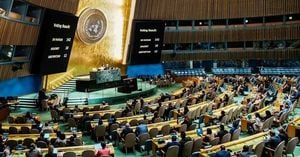The financial benefits of climate-related opportunities seen by the world’s largest companies have more than doubled in the past five years; they identify an average of over $3 billion each. Companies see more business opportunities from tackling climate change than ever before, with the world's biggest businesses now identifying nearly $5 trillion in potential gains — according to data released by CDP, as governments convene this week in Azerbaijan for COP29.
Expectations have increased substantially, with the world’s largest 500 businesses raising the potential financial benefits they see from $2.1 trillion in 2018 to $4.8 trillion in 2023 — more than doubling (127 percent) in the past six years. The analysis from CDP — the non-profit managing the global disclosure system for investors, companies, cities, states, and regions to manage their environmental impacts — is based on listed companies representing over two-thirds of global stock market value and thousands of private companies.
Part of this growth reflects businesses’ ability to identify more opportunities tied to climate mitigation and adaptation efforts. From the wider group of all disclosing companies, opportunities totaling $16 trillion were identified last year, which is comparable to the combined GDP of Germany, India, and Japan. The most impactful opportunities are linked to shifting products and services, attracting new markets, and building climate resilience.
“Companies increasingly see tackling climate change as an investment in the future — and that's how governments need to start seeing their NDCs (Nationally Determined Contributions) ahead of next year,” said CDP CEO Sherry Madera. “This analysis shows there are trillions of opportunities across the global economy. Business now needs governments to lay out plans with sufficient detail for the market to act, realize these gains, and kickstart green growth.” With COP29 focused on finance, the synergy between ambitious business practices and climate goals is seen as the pathway to sustainability.
Despite the recognition of lucrative opportunities, corporate progress toward aligning core business activities with climate goals remains insufficient. According to the MSCI Sustainability Institute’s latest Net-Zero Tracker, the scope and pace of decarbonization efforts of listed companies across 16 nations could only deliver emissions-reduction trajectories tied to a 2.8°C scenario, overshooting the 1.5°C limit necessary to secure a livable future.
CDP’s findings show only 16 percent of companies generate significant revenue from low-carbon products, and the average capital expenditure aimed at climate-transition plans stands at just 25 percent. Firms are struggling to adapt their services and products to seize projected opportunities, indicating the urgent need for stronger NDCs and policy frameworks to mobilize private capital.
“Failure to do so increases the prospect of significant business risks,” but CDP data reveals improved awareness of the financial impacts of climate risks among global firms. The analyzed companies identified over $1.3 trillion in climate-related risks — an increase of 29 percent from 2018 — with regulation, market impacts, and acute physical risks topping the list of concerns.
Increasing transparency around corporate climate ambitions versus actual progress is pivotal for COP negotiations to help governments establish and fulfill economy-wide targets. Encouragingly, the number of companies disclosing environmental data through CDP grew to over 24,800 companies, representing more than 66 percent of total global stock market value.
This growing commitment included over 12,500 small and medium enterprises (SMEs) reporting through CDP’s new SME-specific questionnaire, shifting the focus beyond mere carbon accounting to encompass biodiversity and ecosystem health, which are also integral to effective climate action.
“It is highly encouraging to see more than 12,500 SMEs reported through CDP’s new SME questionnaire,” said Nigar Arpadarai, UN Climate Change High-Level Champion, highlighting the importance of transparency for future-proofing SMEs and supply chains. “CDP has been instrumental in providing small businesses the insights they need to thrive during the green transition.”
Yet, as host country Azerbaijan announces intentions to ramp up fossil fuel production by up to one-third over the coming decade, skepticism abounds about whether COP29 will yield meaningful climate action agreements or financial commitments from the attending 200 countries. This sets the onus on the business sector to drive the necessary innovation and system-wide changes required to sustain both its long-term viability and the planet's health.
At the COP29 World Leaders Climate Action Summit, the Agriculture Innovation Mechanism for Scale (AIM for Scale) unveiled its first-ever, groundbreaking Innovation Package, aimed at providing weather information to help farmers adapt to the impacts of climate change. AIM for Scale, partnered with the Innovation Commission for Climate Change, Food Security, and Agriculture, recognizes the transformative potential of AI-supported weather forecasting, empowering national meteorological and hydrological services to produce high-quality, farmer-centered forecasts. Dissemination of these forecasts can significantly boost resilience for farmers facing the increasing unpredictability of climate change.
A global consortium has committed to mobilizing substantial investments over the next three years to implement the AIM for Scale Weather Package. Notable contributions include the Asian Development Bank (ADB), which plans to invest approximately $300 million to develop advanced weather forecasts for farmers across Asia and the Pacific during 2025-2027. This initiative is part of ADB’s larger food security framework, which aims to address agricultural challenges exacerbated by climate change.
The Inter-American Development Bank (IDB) also plans to leverage weather forecasts within its $280 million lending portfolio over the next three years, announcing plans to support AI-based weather forecast implementation across Latin America and the Caribbean.
The World Bank, too, is aligning its $1.46 billion investments with the AIM for Scale Weather Package, particularly focusing on georeferenced farmer registries, soil information systems, and early warning systems to deliver timely weather information to farmers throughout Africa.
The U.S. Agency for International Development (USAID), alongside NASA, is set to expand the SERVIR program to Central America through $6.6 million of investment, enhancing access to early warning systems and enabling communities to prepare for extreme weather events. This initiative is anticipated to bolster the resilience of over 40 million people, including 11 million employed in agriculture.
Meanwhile, India’s Ministry of Agriculture and Farmers Welfare has ambitious plans to digitally deliver weather forecasts to tens of millions of farmers. Following success reaching 9.45 million farmers initially, the plan symbolizes the country’s commitment to using technology to support its agricultural sector.
Further efforts to empower farmers include the Jameel Observatory's expansion of the CREWSnet initiative to support 8 million smallholder farmers at risk from climate change, and the launch of various AI-supported forecasting initiatives across 30 low and middle-income countries.
Weather services for farmers are just one facet of the international community addressing the multifaceted issues of food insecurity, agricultural adaptation, and climate resilience. The urgency of these initiatives underpins the necessity of international collaboration, especially as the climate crisis accelerates.
Reflecting the continued importance of awareness and adaptation, environmental scientist Keith Tuffley undertook the challenge of crossing the once impenetrable Northwest Passage by sailing his yacht, the Abel Tasman. To raise awareness of the vulnerabilities of the Arctic to climate change, Tuffley incorporated climate stripes — vertical bars of color representing changes in the planet's temperature over time — across the yacht's sails. This innovative design symbolizes the pressing issue of global warming.
The Arctic is experiencing rapid transformation, as sea ice diminishes, altering weather patterns and the Earth's climate. Tuffley’s initiative exemplifies how individuals can leverage their platforms to communicate the importance of climate action, even as data indicates 2023 is likely to be the warmest year recorded. The sentiment echoes among scientists who agree the Arctic's sustenance of ecosystems and its regulation of global climate systems cannot be overlooked.
Many experts believe climate change is also intensifying extreme weather events, underscoring the need for comprehensive research and actionable strategies. Such insight underpins the collective responsibility of stakeholders across sectors and nations as they work toward implementing steadfast mitigation and adaptation measures. Testing initiatives and pilot projects provide the foundation for comprehensive, global efforts to tackle climate change head-on, with every effort contributing to the necessary velocity and scale required to combat impending crises.
Organizations like IFAW are proactive, emphasizing both climate change mitigation and adaptation strategies to advance their mission. By fostering collaborations across sectors and levels of governance, the focus remains on holistic solutions to safeguard vulnerable ecosystems and communities worldwide.



